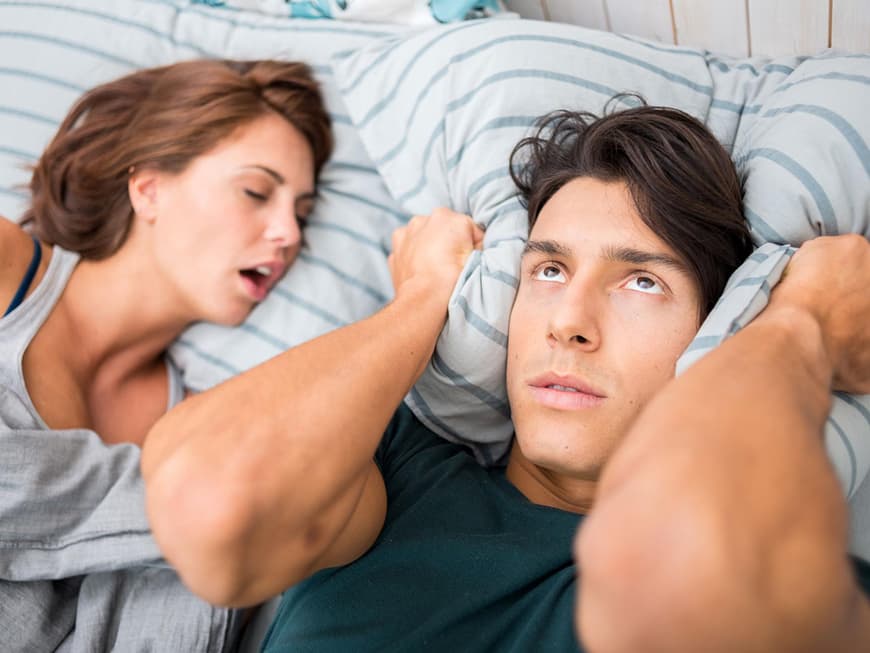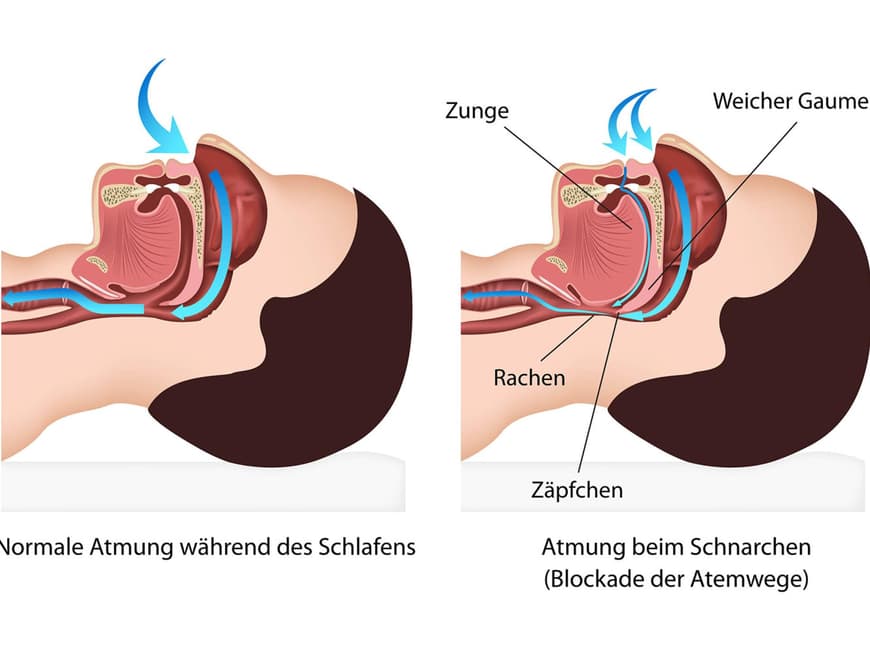When the throat gets tight, the noise level rises
During sleep, the entire musculature relaxes and this also affects the throat: The palate and tongue relax and can block the throat - especially if we sleep on our back. If the overall muscle tension decreases over the years and a few fat pads are added, the throat becomes cramped. The air we breathe can no longer circulate freely, the soft palate and uvula flutter noisily with every breath and we rattle, wheeze or gasp for air. "In women, hormones also play a role. The contraceptive pill, for example, encourages the nocturnal disturbance. However, once the body has become accustomed to the hormonal change, things usually calm down again," says Dr. Feld. The situation is slightly different from the mid-40s, when the menopause begins. During this phase, the body produces less and less oestrogen, which also causes the muscles to slacken. The result: from 50 plus, women snore almost as often as men. However, there is a small difference: "Women generally make less noise," says the sleep physician.
Women snore less and go to the doctor later
The fact that we often only play second fiddle in the nocturnal sawing concert appears to be an advantage, but at second glance it turns out to be a disadvantage. Dr. Feld: "As women snore more quietly, they notice it later, they go to the doctor later and breathing interruptions that pose a health risk are only discovered later."
Mini sensors vibrate us into the right position
"As many women only snore when lying on their back, it is advisable to get used to sleeping on their side," recommends the expert. A gentle nudge from your partner, tennis balls sewn into the back of your pyjama top, a sleeping backpack or even a position trainer can help. A sleeping backpack consists of an angular cushion that is strapped to your back and prevents you from lying on your back. New are mini-sensors that are stuck to the forehead, for example, and register the sleeping position. If we lie on our back, they vibrate slightly and we automatically change position. What works best depends on the individual.
Nose free - and peace and quiet returns
"In 20 percent of snoring cases, it is because nasal breathing is obstructed," explains Dr. Feld. This can be caused by a cold, allergic rhinitis and swollen throat or palatine tonsils. "Nasal sprays, which should be taken shortly before going to sleep, usually help," advises the sleep expert. In some cases, anti-snoring tools such as nasal butterflies - tiny plastic hangers that are inserted overnight and keep the nose clear - can also be useful. "However, permanently swollen throat or palate tonsils are a case for the ear, nose and throat doctor," advises the expert.
A few pounds less often works wonders
The main suspects when it comes to snoring also include being overweight, for example during pregnancy or the menopause. After giving birth or if you manage to lose a few kilograms through a little more exercise and a calorie-reduced diet, the snoring problem is usually solved. Also be careful with alcoholic nightcaps and sedative medication, such as sleeping pills. "Both relax the muscles and increase the risk of snoring," warns Dr. Feld.
Snoring splints keep the airways open
If there is still no peace and quiet in the bedroom, you should consult a sleep doctor. "Snoring becomes dangerous if it robs you or your partner of sleep and you may be suffering from apnoea," warns Dr. Feld. In apnoea, breathing stops and there is a lack of oxygen. Whether this is really the case can be determined in a sleep laboratory (see box below left). Depending on the diagnosis, a snoring splint, which fixes the lower jaw and prevents the tongue from falling back, or an operation can help. However, an operation in which tissue is removed from the airways is only the last option and is often not necessary.
Apnea as a risk factor
Around a third of snorers have several breathing interruptions lasting a few seconds or minutes while sleeping. Apnea is stressful for the body and increases the risk of heart attack, depression and stroke in the long term. The airways are closed by a slack soft palate, resulting in a lack of oxygen. Blood pressure and pulse rate rise, stress hormones are released, those affected startle and gasp audibly for air.
Microsleep
The first sign of apnoea is the feeling of waking up in the morning feeling exhausted despite having slept long enough. However, those affected also become tired quickly during the day and nod off - this microsleep can be dangerous when driving, for example.
Breathing mask
The diagnosis is made by a family doctor, internist or sleep specialist. If the sleep laboratory, blood tests, ECG and lung function test confirm apnoea, patients are given a lower jaw splint or a sleep mask. The splint is individually fitted, pushes the lower jaw forward and thus clears the throat. The mask is placed over the mouth and nose. It creates positive pressure and thus keeps the airways open. However, it takes some getting used to.
App or sleep lab? The best diagnostic methods
Whether snoring is just annoying or associated with breathing interruptions cannot be reliably determined by our partner or ourselves. There are now apps that record and analyze sounds. They do not (yet) offer a reliable diagnosis and experts recommend a sleep laboratory. This means you no longer have to spend the night in hospital, but are wired up to a mobile device that measures your breathing, sounds, oxygen supply and pulse at home.
You might also be interested in this:
Sleep better at last - the best tips for a good night's sleep
How much sleep is healthy?
Stop snoring: The enemy in my bed
Restful sleep at last: which pillow is right for me?
Sleep disorders: causes and help
Valuable sleep tips for a restful night's sleep
Menopause: What to do about sleep disorders?
Sleep yoga: can it work?


